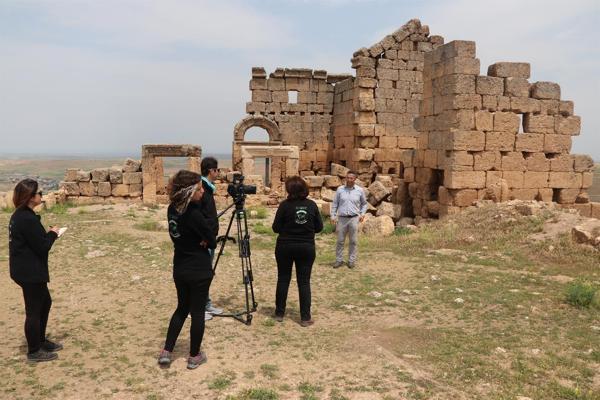Diyarbakır’s Zerzevan Castle featured in international documentary
DİYARBAKIR – Anadolu Agency


The Zerzevan Castle has been chosen as one of the places for the “ICORP on the Road,” a project of the International Council on Monuments and Sites (ICOMOS).
The castle in the southeastern province of Diyarbakır’s Çınar district sheds light on history during excavations that have been continuing for four years. It had served as a military settlement for the Roman Empire.
On an area of 60,000 square meters, the castle has 12-15 meter-high and 1,200 meter-long walls, a 21 meter-long observation and defense tower, a church, an administrative building, residences, granaries and weapon storages, underground sanctuary, shelters, rock tombs, water channels and 54 cisterns.
The “ICORP on the Road” project showcases inspiring stories by professionals and local communities from around the world about post-disaster response and recovery of cultural heritage through documentaries, “campfire talks” and exhibitions.
One of the documentaries prepared within the scope of the project will be dedicated to the Zerzevan Castle.
Directed by ICOMOS board member and Secretary-General Professor Zeynep Gül Ünal, a team consisting of Rohit Jigyasu, Chris Marrion, Mehmet Ünal, Zeynep Ece Atabay, Tuğçe Darendeli, Eda Ateş and Ali Kemal Ceylan made the documentary shooting of the castle.
Ünal said the first episode of the project was shot in Nepal.
She said their aim is to tell the stories of regions which have overcome disasters at firsthand.
“The Katmandu Valley received very big damage during the Gorkha earthquake in 2015 in Nepal. We shot the works that continued for three years in the region with the support of the locals. Within the scope of the project, the Zerzevan Castle is our second stop. The castle collapsed hundreds of years ago. It came to light four years ago during excavations and made great contributions to the development of the region,” Ünal said.
She said the archaeological field revived thanks to the works in the castle, which also contributed to the region.
“The Mithras Temple in the castle draws great interest from the world. It is also important for the academic world because it is the latest found temple. We wanted to include this story in this project, which will go to many countries. We have so far made important stories from the countries and Zerzevan Castle is one of them,” Ünal said.
Two-day shooting
Ünal said the first two episodes of the documentary were set to be released by the end of June, and the first screening would be made on the ICOMOS website.
“Later on, we will choose platforms to reach wider audiences. The documentary is in English. We will also use the national language of 12 countries. Within the scope of the project, we will go to India, Mali and Afghanistan,” she added.
Dicle University archaeology department academic and the head of the excavations, Aytaç Coşkun, said that when they had initiated excavations in 2014, there were only the tower and the church, while the other structures were underground.
He said they had unearthed many structures. “Zerzevan Castle draws great interest both from Turkey and abroad. This project is very important for the promotion of Turkey and Diyarbakır.”
The Zerzevan Castle
The military settlement is located on a 124-meter-high rocky hill on an ancient route in the strategic point between Amida (modern-day Diyarbakır) and Dara (near modern-day Mardin). Due to its location, the Zerzevan Castle dominated the whole valley, and thus was a key Roman garrison and a scene of great military confrontations between the Romans and the Sassanians. It was called “Samachi” in the Roman era.
The walls and buildings in the settlement reached their final form through restoration and reconstruction during the reigns of Anastasios I (491-518) and Justinianos I (527-565).
